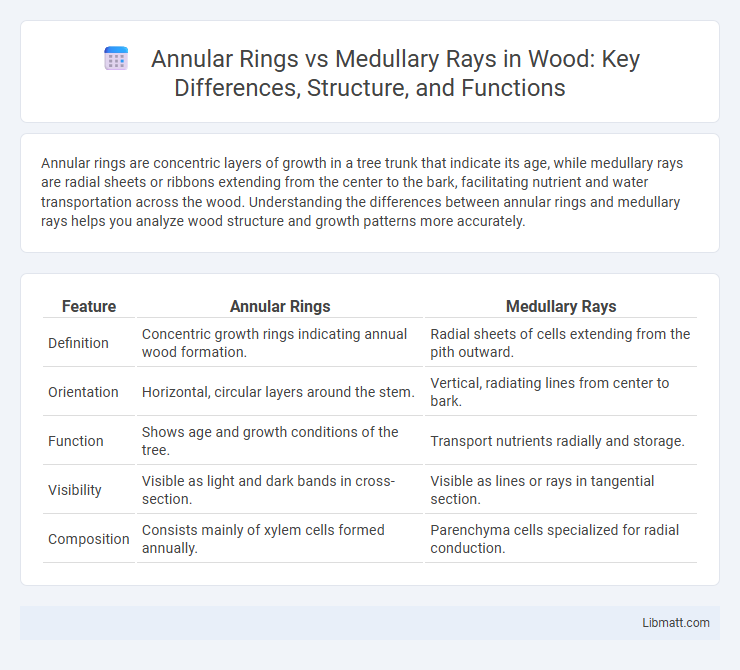Annular rings are concentric layers of growth in a tree trunk that indicate its age, while medullary rays are radial sheets or ribbons extending from the center to the bark, facilitating nutrient and water transportation across the wood. Understanding the differences between annular rings and medullary rays helps you analyze wood structure and growth patterns more accurately.
Table of Comparison
| Feature | Annular Rings | Medullary Rays |
|---|---|---|
| Definition | Concentric growth rings indicating annual wood formation. | Radial sheets of cells extending from the pith outward. |
| Orientation | Horizontal, circular layers around the stem. | Vertical, radiating lines from center to bark. |
| Function | Shows age and growth conditions of the tree. | Transport nutrients radially and storage. |
| Visibility | Visible as light and dark bands in cross-section. | Visible as lines or rays in tangential section. |
| Composition | Consists mainly of xylem cells formed annually. | Parenchyma cells specialized for radial conduction. |
Introduction to Annular Rings and Medullary Rays
Annular rings, also known as growth rings, represent the concentric layers of wood produced during each growing season, revealing a tree's age and growth conditions. Medullary rays, in contrast, are radial sheets or ribbons of tissue extending from the tree's center outward, crucial for nutrient transport and storage within the wood. Understanding the structural and functional differences between annular rings and medullary rays enhances your knowledge of tree anatomy and wood identification.
Definition of Annular Rings
Annular rings, also known as growth rings, are concentric layers of wood produced annually by trees, reflecting seasonal growth variations. These rings provide valuable information about the tree's age and environmental conditions during each growth cycle. Understanding annular rings helps you analyze wood structure and distinguish them from medullary rays, which are radial, horizontal cells that transport nutrients laterally within the tree.
Definition of Medullary Rays
Medullary rays are radial sheets or ribbons of parenchyma cells extending from the center of the tree outward, facilitating horizontal transport of nutrients and water. Unlike annular rings, which form concentric growth layers marking yearly increments, medullary rays appear as spokes in the wood anatomy, providing storage and structural support. Understanding the distinct roles of medullary rays helps you interpret wood grain patterns and assess timber quality.
Anatomical Importance in Wood Structure
Annular rings represent the growth layers formed annually in trees, crucial for determining age and growth patterns, while medullary rays are radial sheets of parenchyma cells responsible for lateral transport and storage within the wood. Annular rings provide structural strength and influence mechanical properties, whereas medullary rays contribute to nutrient distribution and resistance to splitting. Together, these anatomical features enhance wood's durability and functional efficiency in vascular transport.
Formation Process of Annular Rings
Annular rings form through the seasonal variation in growth rates within a tree, where periods of rapid cell division during favorable conditions alternate with slower growth phases, producing distinct concentric layers of xylem. These rings reflect changes in environmental factors like temperature and moisture, capturing annual growth cycles visibly in the wood structure. Understanding the formation process of annular rings can help you interpret tree age and historical climate conditions.
Formation Process of Medullary Rays
Medullary rays form during secondary growth when parenchyma cells develop radially between the xylem and phloem tissues, facilitating horizontal transport. Unlike annular rings, which reflect seasonal growth variations, medullary rays arise from the vascular cambium and extend outward from the pith to the bark. When examining wood structure, understanding the formation process of medullary rays highlights their role in nutrient storage and radial conduction within your plant's stem.
Visual Differences: Identification Tips
Annular rings appear as concentric, circular bands marking the age of a tree, typically visible in cross-sectional cuts of wood, while medullary rays manifest as radial streaks extending from the center toward the bark. Annular rings are denser and darker lines that indicate seasonal growth variations, whereas medullary rays are lighter, ribbon-like structures that facilitate nutrient transport. To identify them visually, observe that annular rings form closed loops around the pith, while medullary rays run perpendicular to these rings, creating a distinctive radial pattern.
Functional Roles in Trees
Annular rings in trees primarily indicate periods of growth, representing the transition between seasons and helping to measure a tree's age and growth rate. Medullary rays function as radial conduits for nutrients and water, facilitating horizontal transport between the inner vascular tissues and outer bark. Both structures contribute to the tree's overall vascular system but serve distinct roles in growth tracking and nutrient distribution.
Significance in Wood Quality and Applications
Annular rings, representing annual growth layers, influence wood density and mechanical strength, crucial for structural applications and determining lumber quality. Medullary rays, radial tissues distributing nutrients, significantly affect wood's aesthetic appeal and dimensional stability, often valued in fine woodworking and veneer production. Understanding the balance between these features guides optimal wood selection for construction, furniture-making, and decorative purposes.
Annular Rings vs. Medullary Rays: Key Differences
Annular rings, also known as growth rings, are concentric layers of wood formed annually in the secondary xylem, indicating the age and growth conditions of a tree, while medullary rays are radial sheets or ribbons extending from the center to the bark, facilitating the horizontal transport of nutrients and water. Annular rings primarily contribute to the vertical structural strength and storage of carbohydrates, whereas medullary rays provide essential lateral communication within the wood. The distinct orientation and function of annular rings versus medullary rays are crucial for understanding wood anatomy and growth patterns in dendrology and forestry.
Annular rings vs medullary rays Infographic

 libmatt.com
libmatt.com